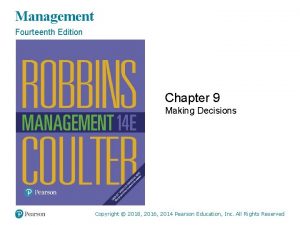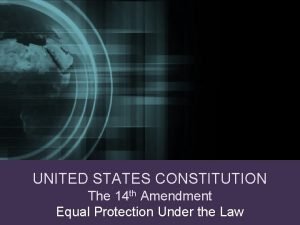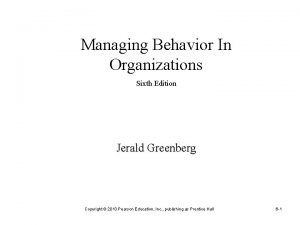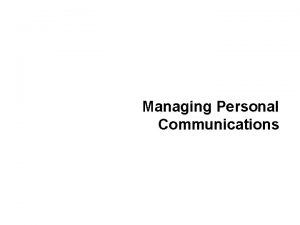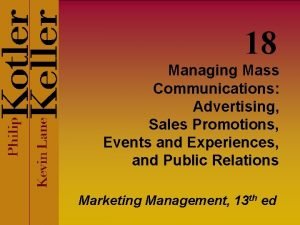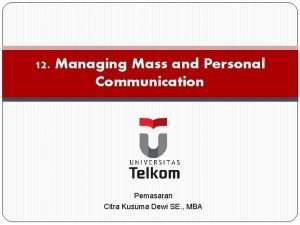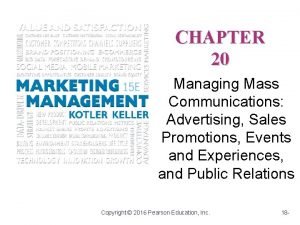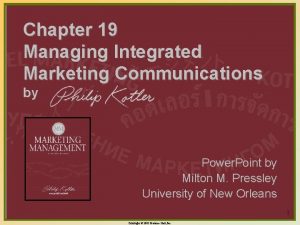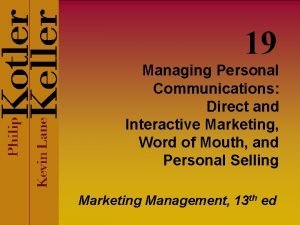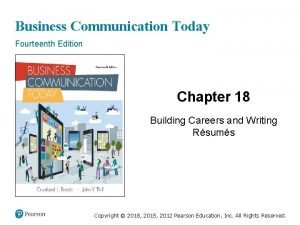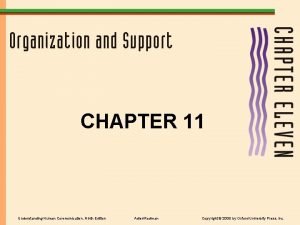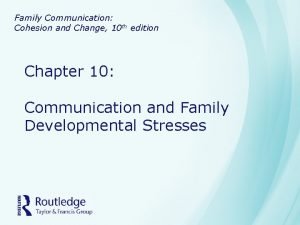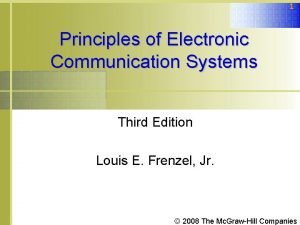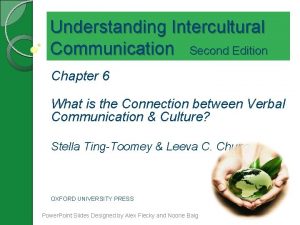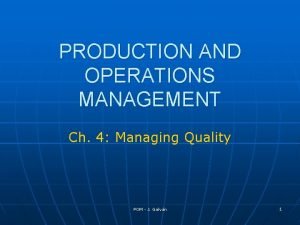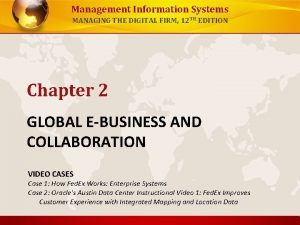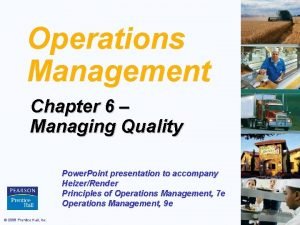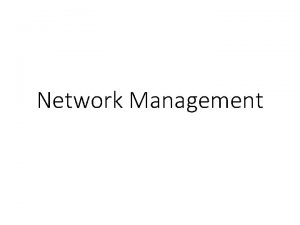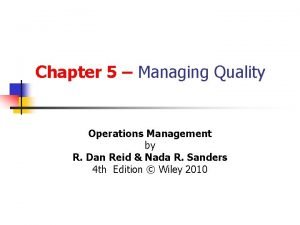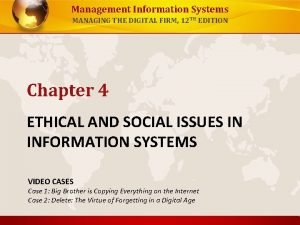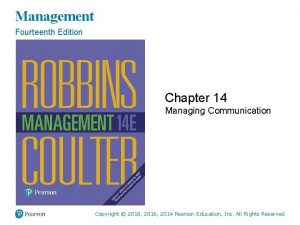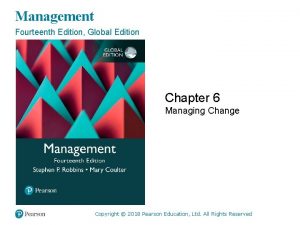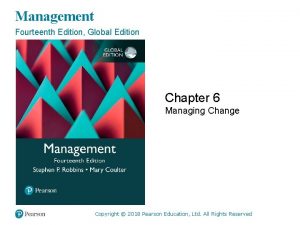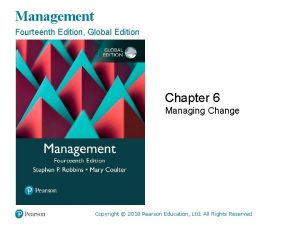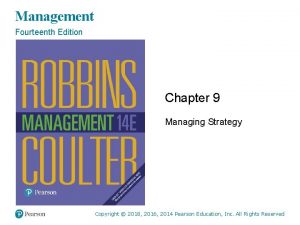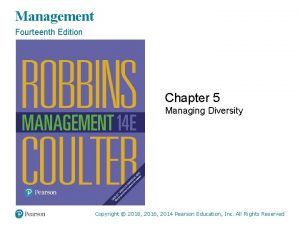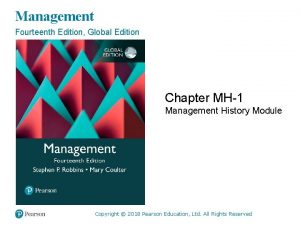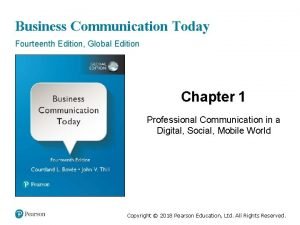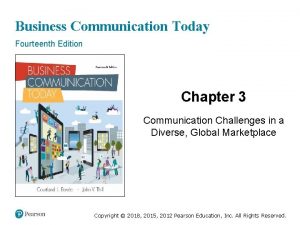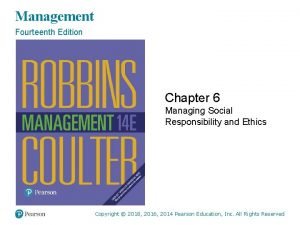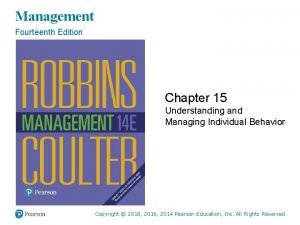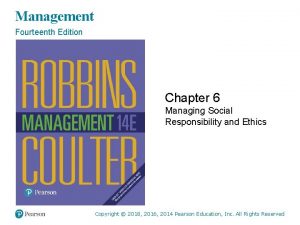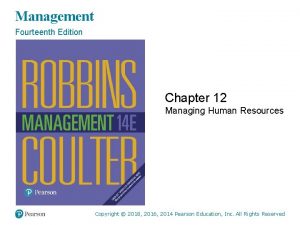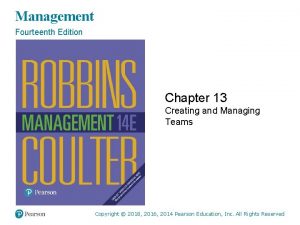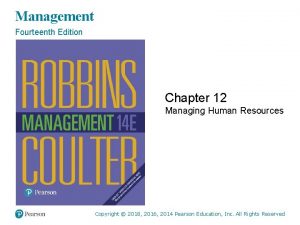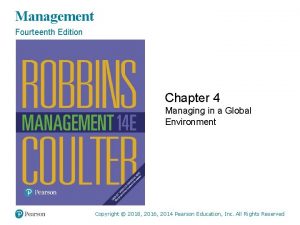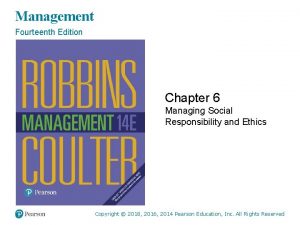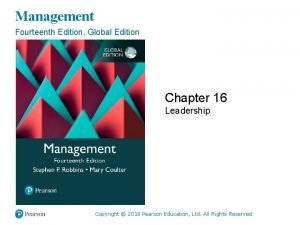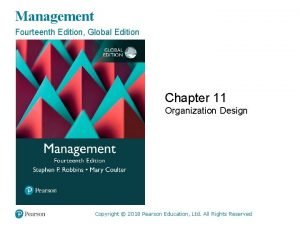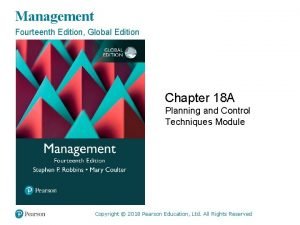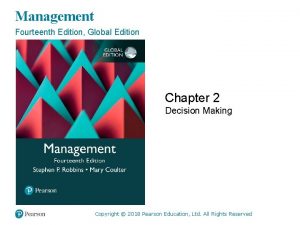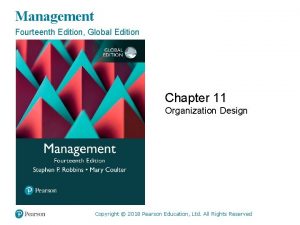Management Fourteenth Edition Chapter 14 Managing Communication Copyright



































- Slides: 35

Management Fourteenth Edition Chapter 14 Managing Communication Copyright © 2018, 2016, 2014 Pearson Education, Inc. All Rights Reserved

What is Communication? • Communication: the transfer and understanding of meaning • Interpersonal communication: communication between two or more people • Organizational communication: all the patterns, networks, and systems of communication within an organization Copyright © 2018, 2016, 2014 Pearson Education, Inc. All Rights Reserved

Functions of Communication • Control • Motivation • Emotional expression • Information Copyright © 2018, 2016, 2014 Pearson Education, Inc. All Rights Reserved

Methods and Challenges of Interpersonal Communication • Message: a purpose to be conveyed – Encoding: converting a message into symbols – Channel: the medium a message travels along – Decoding: retranslating a sender’s message Copyright © 2018, 2016, 2014 Pearson Education, Inc. All Rights Reserved

Methods • Communication process: the seven elements involved in transferring meaning from one person to another – Noise: any disturbances that interfere with the transmission, receipt, or feedback of a message Copyright © 2018, 2016, 2014 Pearson Education, Inc. All Rights Reserved

Exhibit 14 -1 The Interpersonal Communication Process Exhibit 14 -1 illustrates the elements of the communication process. Copyright © 2018, 2016, 2014 Pearson Education, Inc. All Rights Reserved

Which Communication Method Should Be Used? Criteria Question Feedback How quickly can the receiver respond to the message? Complexity capacity Can the method effectively process complex messages? Breadth potential How many different messages can be transmitted using this method? Confidentiality Can communicators be reasonably sure their messages are received only by those intended? Encoding ease Can sender easily and quickly use this channel? Decoding ease Can receiver easily and quickly decode messages? Time-space constraint Do senders and receivers need to communicate at the same time and in the same space? Cost How much does it cost to use this method? Interpersonal warmth How well does this method convey interpersonal warmth? Formality Does this method have the needed amount of formality? Scanability Does this method allow the message to be easily browsed or scanned for relevant information? Time of consumption Does the sender or receiver exercise the most control over when the message is dealt with? Copyright © 2018, 2016, 2014 Pearson Education, Inc. All Rights Reserved

Nonverbal Communication • Nonverbal communication: communication transmitted without words – Body language: gestures, facial configurations, and other body movements that convey meaning – Verbal intonation: an emphasis given to words or phrases that conveys meaning Copyright © 2018, 2016, 2014 Pearson Education, Inc. All Rights Reserved

Exhibit 14 -2 Comparison of Communication Methods (1 of 3) Exhibit 14 -2 provides a comparison of various communication methods. Copyright © 2018, 2016, 2014 Pearson Education, Inc. All Rights Reserved

Exhibit 14 -2 Comparison of Communication Methods (2 of 3) Exhibit 14 -2 provides a comparison of various communication methods. Copyright © 2018, 2016, 2014 Pearson Education, Inc. All Rights Reserved

Exhibit 14 -2 Comparison of Communication Methods (3 of 3) Exhibit 14 -2 provides a comparison of various communication methods. Copyright © 2018, 2016, 2014 Pearson Education, Inc. All Rights Reserved

Barriers • Information overload: when information exceeds our processing capacity • Filtering: the deliberate manipulation of information to make it appear more favorable to the receiver • Jargon: specialized terminology or technical language that members of a group use to communicate among themselves Copyright © 2018, 2016, 2014 Pearson Education, Inc. All Rights Reserved

Overcoming the Barriers • Use feedback • Simplify language • Listen actively – Active listening: listening for full meaning without making premature judgments or interpretations • Constrain emotions • Watch nonverbal cues Copyright © 2018, 2016, 2014 Pearson Education, Inc. All Rights Reserved

Exhibit 14 -3 Active Listening Behavior Specific behaviors that active listeners demonstrate are listed in Exhibit 14 -3. Copyright © 2018, 2016, 2014 Pearson Education, Inc. All Rights Reserved

Formal Versus Informal • Formal communication: communication that takes place within prescribed organizational work arrangements • Informal communication: communication that is not defined by the organization’s structural hierarchy Copyright © 2018, 2016, 2014 Pearson Education, Inc. All Rights Reserved

Direction of Flow (1 of 2) • Downward: communication that flows downward from a manager to employees – Town hall meeting: informal public meetings where information can be relayed, issues can be discussed, or employees can be brought together to celebrate accomplishments Copyright © 2018, 2016, 2014 Pearson Education, Inc. All Rights Reserved

Direction of Flow (2 of 2) • Upward communication: communication that flows upward from employees to managers • Lateral communication: communication that takes place among any employees on the same organizational level • Diagonal communication: communication that cuts across work areas and organizational levels Copyright © 2018, 2016, 2014 Pearson Education, Inc. All Rights Reserved

Networks • Communication networks: the variety of patterns of vertical and horizontal flows of organizational communication • Grapevine: the informal organizational communication network Copyright © 2018, 2016, 2014 Pearson Education, Inc. All Rights Reserved

Exhibit 14 -4 Organizational Communication Networks Exhibit 14 -4 illustrates three common communication networks. Copyright © 2018, 2016, 2014 Pearson Education, Inc. All Rights Reserved

Workplace Design and Communication • Open workplaces: workplaces with few physical barriers and enclosures Copyright © 2018, 2016, 2014 Pearson Education, Inc. All Rights Reserved

The 24/7 Work Environment • IT has made it possible to stay connected around the clock, seven days per week. • IT has made it possible for people in organizations to be fully accessible, at any time, regardless of where they are. Copyright © 2018, 2016, 2014 Pearson Education, Inc. All Rights Reserved

Working From Anywhere • Wireless communication technology has the ability to improve work for managers and employees. Copyright © 2018, 2016, 2014 Pearson Education, Inc. All Rights Reserved

Social Media • Devoting a channel for information exchange about a specific topic can help compartmentalize the conversation. • It can also start a useful conversation in which employees can share their experiences and make suggestions for creating competitive advantage. Copyright © 2018, 2016, 2014 Pearson Education, Inc. All Rights Reserved

Balancing the Pluses and Minuses • Communication and the exchange of information among organizational members are no longer constrained by geography or time. • Constantly staying connected has its downsides, such as impeding creativity. Copyright © 2018, 2016, 2014 Pearson Education, Inc. All Rights Reserved

Choosing the Right Media • It is important for managers to understand the situations in which one or more media facilitates effective communication. Copyright © 2018, 2016, 2014 Pearson Education, Inc. All Rights Reserved

Managing Communication in a Digitally Connected World • Legal and security issues • Personal interaction Copyright © 2018, 2016, 2014 Pearson Education, Inc. All Rights Reserved

Managing the Organization’s Knowledge Resources • Managers need to enable employees to communicate and share knowledge so they can learn from each other. Copyright © 2018, 2016, 2014 Pearson Education, Inc. All Rights Reserved

The Role of Communication in Customer Service • The three components: 1. customer 2. service organization 3. individual service provider Copyright © 2018, 2016, 2014 Pearson Education, Inc. All Rights Reserved

Getting Employee Input • Letting employees know that their opinions matter is an essential first step in building effective suggestions systems. Copyright © 2018, 2016, 2014 Pearson Education, Inc. All Rights Reserved

Exhibit 14 -5 How to Let Employees Know Their Input Matters Suggestion Hold town hall meetings where information is shared and input solicited Provide information about what’s going on, good and bad. Invest in training so that employees see how they impact the customer experience. Analyze problems together—managers and employees. Make it easy for employees to give input by setting up different ways for them to do so (online, suggestion box, preprinted cards, and so forth). Copyright © 2018, 2016, 2014 Pearson Education, Inc. All Rights Reserved

Communicating Ethically • Ethical communication: communication that includes all relevant information, is true in every sense, and is not deceptive in any way Copyright © 2018, 2016, 2014 Pearson Education, Inc. All Rights Reserved

Sharpening Your Persuasion Skills • Persuasion skills: skills that enable a person to influence others to change their minds or behavior Copyright © 2018, 2016, 2014 Pearson Education, Inc. All Rights Reserved

Sharpening Your Speaking Skills • Speaking skills: skills that refer to the ability to communicate information and ideas in talking so others will understand Copyright © 2018, 2016, 2014 Pearson Education, Inc. All Rights Reserved

Sharpening Your Writing Skills • Writing skills: skills that entail communicating effectively in text as appropriate for the needs of the audience Copyright © 2018, 2016, 2014 Pearson Education, Inc. All Rights Reserved

Sharpening Your Reading Skills • Reading skills: skills that entail an understanding of written sentences and paragraphs in workrelated documents. Copyright © 2018, 2016, 2014 Pearson Education, Inc. All Rights Reserved
 Management fourteenth edition
Management fourteenth edition Fourteenth amendment
Fourteenth amendment Summer of his fourteenth year poem
Summer of his fourteenth year poem Managing behavior in organizations 6th edition
Managing behavior in organizations 6th edition Managing front office operations 10th edition
Managing front office operations 10th edition Understanding human communication 14th edition chapter 1
Understanding human communication 14th edition chapter 1 Mis chapter 6
Mis chapter 6 Zulily case study
Zulily case study Principles of management stephen p robbins
Principles of management stephen p robbins Managing personal communications
Managing personal communications Five m of advertising
Five m of advertising Designing and managing marketing communications
Designing and managing marketing communications Managing mass communication
Managing mass communication Managing mass communication
Managing mass communication Designing and managing integrated marketing channels
Designing and managing integrated marketing channels Managing personal communication
Managing personal communication Principles of electronic communication systems 3rd edition
Principles of electronic communication systems 3rd edition Business communication today chapter 1
Business communication today chapter 1 Fundamentals of organizational communication
Fundamentals of organizational communication Fundamentals of organizational communication 9th edition
Fundamentals of organizational communication 9th edition Adler and rodman 2006
Adler and rodman 2006 Family communication cohesion and change 10th edition
Family communication cohesion and change 10th edition Principles of electronic communication systems 3rd edition
Principles of electronic communication systems 3rd edition Understanding intercultural communication 2nd edition
Understanding intercultural communication 2nd edition Managing quality in operations management
Managing quality in operations management Managing assets vs asset management
Managing assets vs asset management Managing assets vs asset management
Managing assets vs asset management Management information system managing the digital firm
Management information system managing the digital firm Chapter 6 managing quality
Chapter 6 managing quality Managing entity network management
Managing entity network management Introduction to network management
Introduction to network management Managing quality in operations management
Managing quality in operations management Management information systems managing the digital firm
Management information systems managing the digital firm Chapter 1 managing risk when driving
Chapter 1 managing risk when driving Chapter 8 managing stress and anxiety
Chapter 8 managing stress and anxiety Chapter 4 managing stress and coping with loss
Chapter 4 managing stress and coping with loss
